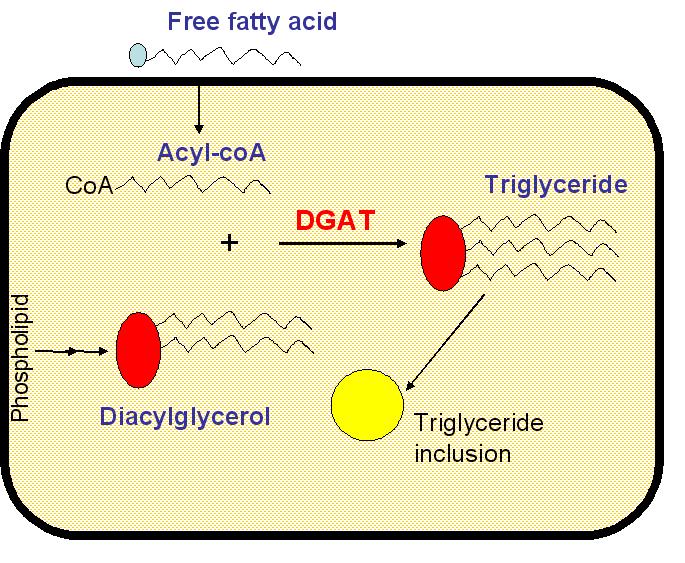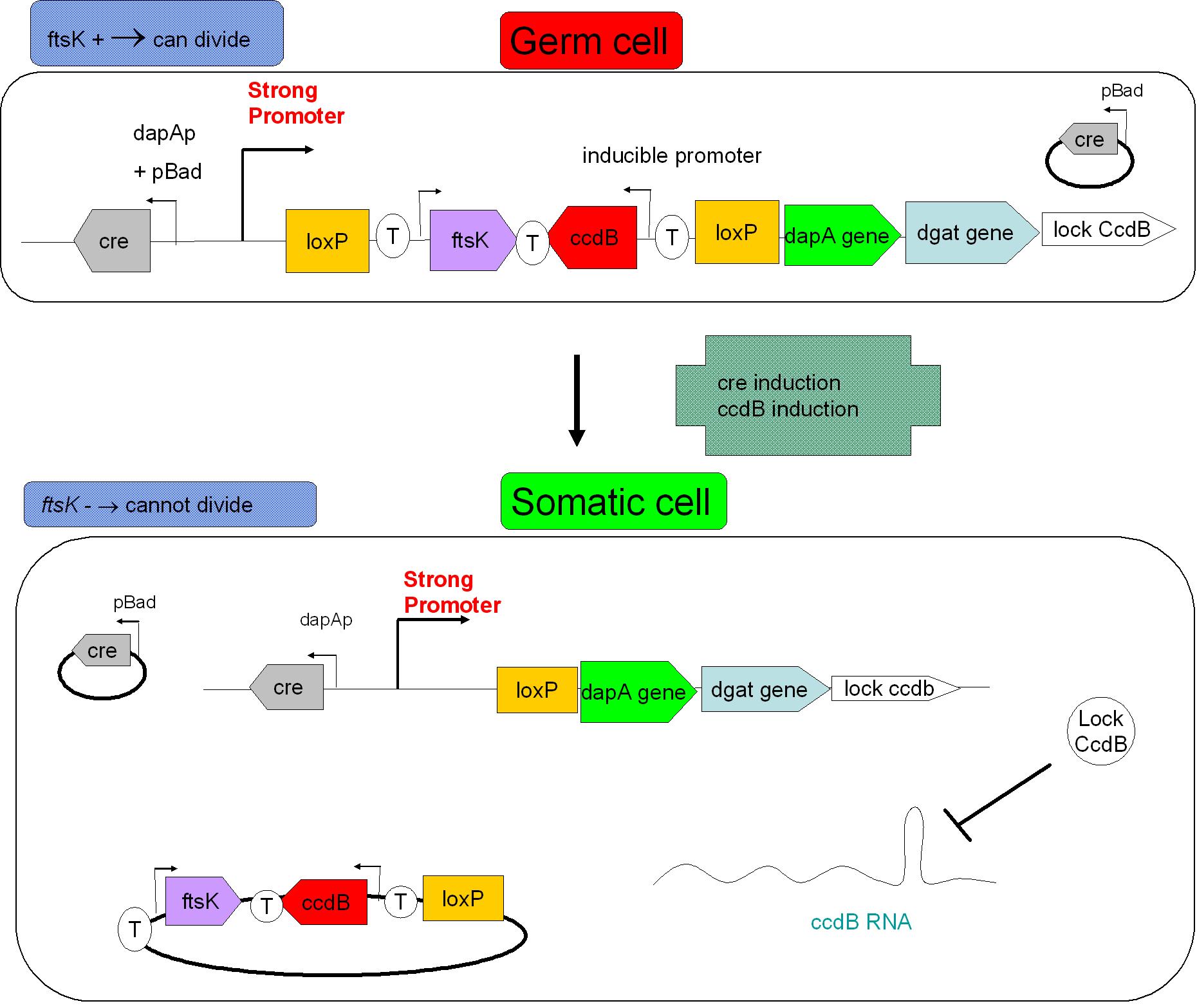Paris/Perspectives
From 2007.igem.org
(→Security device) |
(→Security device) |
||
| Line 31: | Line 31: | ||
| - | For details on proposed technical solutions to this challenge, [[Security device| | + | For details on proposed technical solutions to this challenge, [[Security device|see here]] |
===Metabolic engineering=== | ===Metabolic engineering=== | ||
Revision as of 23:04, 24 October 2007
SMB is composed of a germ line and a soma. Germ cells are responsible of the reproduction while the sterile somatic cells, are unable generate a population independently themselves but are essential for the germ line, by exporting Dap compound. The special feature of our system, the coexistence of two independent cell types, one dedicated to reproduction and the other sterile, render it a potentially interesting tool for synthetic biology.
We envision two immediate applications to the Synthetic Multicellular Bacterium. It could be used as a “metabolic plant” or as “security device”
Contents |
System improvement through directed evolution
Applications
Decoupling reproduction faculty and transgene expression
SMB is made up with a germ line and somatic line. Germ cells are responsible for the reproduction of the organism and the others, the sterile somatic cells, are unable to build a new organism and themselves but are essential for the germ line, exporting Dap compound. That is the basic property of our SMB and this is the key to original approaches.
Indeed the reproductive faculty in our system is independent with DAP production. Either the cell produces Dap (somatic cell) or it is able to divide. We can also imagine adding a transgene downstream the dapA gene. What would be the consequence? The somatic cell would be able to synthesize a new gene product. Knowing the soma is not able to divide and reproduce the organism, we are able to disrupt the connection between the reproduction of the system and the expression of the transgene leading to interesting applications.
We would like to develop two sides of this system: metabolic engineering and secured genetic modified organism (security device).
Security device
We also came up with the idea of modifying the synthetic organism in order to allow on demand, full differentiation of the germ line into soma in a secured fashion. Why would we want to do that? This possibility is to be considered in the face of biohazard risks. Release of GM organisms in the environment poses ethical as well as technical questions. “Biological security” should be a prime concern in synthetic biology.
If a task is to be transiently performed by a GM organism in the open environment, a major problem is persistence of the GM organism, with potential risks of proliferation and transgene dissemination. A possible solution, already used for some GM crops, is to render the organisms sterile. Can this solution be implemented for GM bacteria, in bioremediation systems for instance? Using a modified version of our SMB, the answer is yes. The SMB comprises two cell types, one being the soma, a group of cells that have a longer lifetime than wt E.coli cells & are unable to replicate. The soma cells have the required characteristics for transient use in open environment.
A next consideration is then: can full differentiation be induced in the SMB? In order to achieve this, two events should be initiated:
- Induction of a massive differentiation of the germ line into soma cell
- Followed by selective death of the persistent germ line cells.
For details on proposed technical solutions to this challenge, see here
Metabolic engineering
A bacterial multicellular organism could allow optimizing the production of compounds deleterious to the cell. If you try to optimize the production of such a compound in a classical bacteria (E.coli for instance), you will reach a trade off between the production of your compound and the growth of the cell because the reproduction capacity is linked to the expression of the toxic transgene. The synthetic organism could in part bypass this problem by partially decoupling growth from synthesis of the exogenous compound. It could indeed be modified so that the soma only will produce the noxious molecule and the germ line will multiply. If there is a way to screen for the production of this molecule, we can then select the germ line whose soma would have the best yield. As long as the production doesn't impair too much the capacity of the soma to feed the germ line, the optimization can go on. Thus, there is also a trade off in this case, but it might very well be more favorable to the optimization than the trade off between production and growth. At least, this is worth testing. Of course, all this is only possible if the germ line is not affected by the production of the soma. Compounds that could be optimized in this way are thus constrained to molecules that can be noxious in the cell, but that do not affect it to much if in the medium.
E. Colight: towards a new slim diet
Project
Finally, the last part of our project would be to bring together the synthetic organism, the optimization of a compound noxious to the bacteria, and the security device. To do so, we'd like to optimize the production of triglycerides in the soma cells of our synthetic organism. We would then be able to differentiate all the germ line of the synthetic organism into soma in a secured way. Those super triglycerides-producing-not-able-to-divide cells could then be ingested. The fatty acids they would stock would be as many fatty acids you will not absorb! Eat fat, don't get fat!
Triglycerides are made of a molecule of glycerol esterified by three fatty acids. When ingested they are hydrolysed by lipase in the stomach and the duodenum, into glycerol and free fatty acids. Enterocytes are only able to absorb free fatty acids and glycerol and recombined them in the cytoplasm into triglycerides that will be free in the lymphatic system then in the blood within fatty vesicles called chylomicrons.
When we are becoming fat, it is because we have more input than output energy, lipid energy. Knowing that gut is full with bacteria forming the gut microflora (we have 1013 of our cells in our body and 1014 bacteria with the majority in the gut!), we could imaging having bacterium able to absorb fatty acids and form triglycerides intracellular inclusion. These triglycerides are not able to be absorbed by enterocytes! Input lipid is decreased! Eat fat, don't get fat!
In fact a drug, orlistat, already exists and shows that the concept of decreasing the lipid input works. It comes from a bacterial lipase inhibitor (from Streptomyces toxytricini). It is able to inhibit pancreatic lipase and is used to cure obese people and type 2 diabetes with hypocaloric cure. At the standard prescription dose of 120 mg three times daily before meals, orlistat prevents approximately 30% of dietary fat from being absorbed (Thomson PDR, 2006).
E.coli is the most used bacterium in synthetic biology and... belongs to the gut microflora! We could also imagine genetically engineering E. coli called E. colight to stock triglycerides into inclusions! Knowing that 40% of E.coli is renewed every day, these triglyceride-fulled bacteria will leave the gut with faeces! With the security device described above and derived from our SMB we should have a safe GMO with two hours life expectancy. This short action could be counterpart by repetitive ingestion of E. colight (yoghurts for example).
E.colight project is also made up with 2 independent parts. First we have to create the SMB to implement the secured module. Second E.coli has to absorb free fatty acid and to synthesize triglycerides in the cytoplasm.
Triglyceride synthesis
See Results: TG synthesis
Secured device
See Security device for the concept. The final contruction would be this one:
Another biomedical applications
Crohn disease and hemorrhagic recto-colitis are both autoimmune diseases located in the intestine. These diseases are thought to be caused by tolerance disruption of the body to its intestinal flora leading to abnormal inflammatory reponses. For example proinflammatory cytokines are produced and generate intestine lesions responsible of clinical symptoms. New therapies are now targeting inflammatory cytokines. We could also imagine producing IL10 or IL11 in our secured SMB. These anti-inflammatory cytokines could also limit the extension of inflammatory lesions.
References:
- 2006 Physicians' Desk Reference (PDR). Thomson PDR
- BBa_I718002


